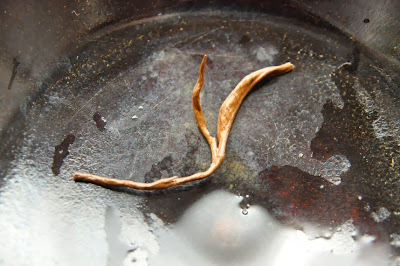This new addition to my selection is the famous '7542' raw puerh cake. Many regard this cake as the follow-up to the "Luyin" (green mark) puerh from the 60s. Having seen both next to each other, I must agree that both cakes look very similar when you look at their mix of dry leaves.
7542 is the name of the recipe.
'75' stands for the year when it was started: 1975.
'4' stands for a certain mix of leaves. In the case of this cake, 4 means a mix that contains smaller leaves and more buds that the
'8582' cake, for instance.
'2' stands for the Menghai Tea Factory.
The buds are the easiest leaves to spot on a raw puerh cake: they keep the lighter yellow/gold color.
There are many pitfalls in finding a good '7542':
- Fakes: the more famous a puerh is, the more forgeries there are!
- Age: This is a recipe that has been produced year after year until now. How do you know its age when the wrapper stays the same?
- Quality of the leaves: Is this 7542 recipe stable in quality over the years?
- Storage: How clean was it? Did it go through a wodui (fake aging) period?
- Price : A high price is not a guarantee that it's real or good. Too good a bargain, though, is a sign of problems.
There is nothing written on this cake that tells us its age. My source says it's from spring 1999. To confirm this information, the best is to compare it to other puerhs that have the same age (more or less). From a visual point of view, it's the color of the puerh buds that will give the most clues about the age of the puerh. Because they turn brown very slowly. Second, the brew itself will also tell us how old it feels. That's where reliable samples are essential to provide good benchmarks to evaluate a puerh.
Visually, we can also tell that these leaves haven't been through a wodui process, otherwise their color would be much more evenly dark brown. We can also see that the wrapper is quite clean. There are no stains from water or tea the paper. The smell, on the other hand, points toward a typical old puerh storage scent: old wood, old basement smell.
For this very first brewing, I have easily flaked 3 grams from the cake without breaking any leaf.
To get an accurate brew, I have opted for a simple porcelain gaiwan. My goal isn't to make the best brew today, but to get to know these leaves and confirm that they are legit (or not).
I want to push these leaves to their limits and test their quality. Quality will help determine if this is a real '7542' or a fake.
Nevertheless, I can't resist using my Nilu on this cooler day. The red charcoals slowly heat my silver kettle. The silver will provide a very sharp and very hot water for these brews. The charcoals add a sweet scent and a very cosy, 'take it slow' atmosphere.
Indeed, there is no rush with my brews. Each lasts several minutes. No rinsing of the leaves, either, since the cake is clean.
In 1999, the CNNP company (China National Native Produce) is still a state company and hasn't been privatized, yet. It was still operating like it had for decades. The privation happened in the early 2000s and this major change probably explains why consequently the quality of this recipe diminished greatly afterwards: the new owners of the brand wanted a quick return on their investment...
The reputation of recent 7542 disappeared like steam in the air!
The first brew we obtain is dark red turning slightly brown. This color confirms that there is no cooked puerh mixed here (or the brew would be much darker).
The camphor and old wood scents are very powerful and persisting. The tea coats the whole mouth quite comfortably. There's still some sharpness and astringency due to its still young age. But despite this concentration, the brew tastes very smooth and clean overall. Its aftertaste is amazingly powerful. There are so many nice things happening in the mouth: salivation, releasing of sweetness in the throat... The stomach feels warm: good chaqi.
Another important characteristic: the mouth and the tongue continue to feel 'clean' and light.
The follow-up brews develop even more this clean and pure taste combined with these nice old raw puerh smells and the powerful aftertaste. This is a cake with lots of energy and a good balance.
The quality of the brews and the endurance of the leaves convinces me that this is indeed a puerh of high quality. A real '7542' from the year 1999 that has been well stored in Taiwan.
The open leaves all unfurl well and don't show any sign of having been artificially fermented. There's a generous amount of buds among these leaves. But there are also some thick stems. These are also quite nice to have, as I have experienced on the '
8582'
Acquiring a cake or a sample of this puerh makes a lot of sense at the current market prices. Very old puerhs have so much increased in value these recent years that they have become very expensive. 'High quality' young puerhs are selling at relatively high prices and it isn't easy to tell their quality or how well they will age. This classic, iconic '7542', on the other hand, is already 14 years old (that's also 14 years less to wait) and comes at a very reasonable and attractive price for its launch. (It's 1 dollar per gram or less. Valid through 2013 only.)
Enjoy this classic puerh with age, character, power and harmony!
Update: For GN, here is a better picture of the neifei. (It's very difficult to remove without breaking it!)


































































